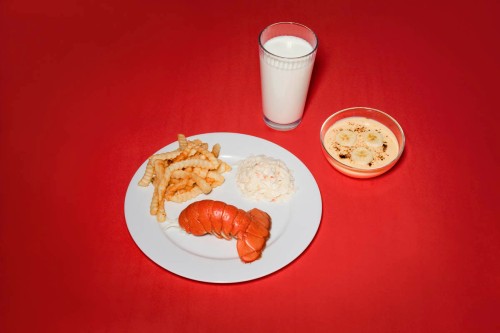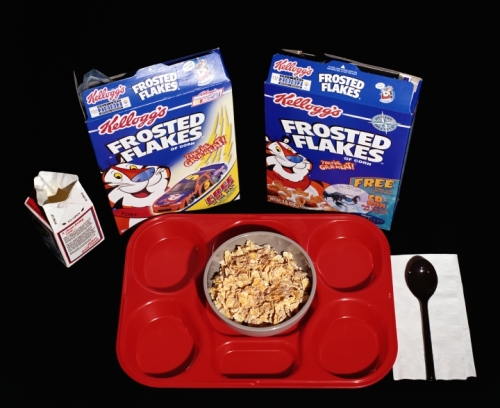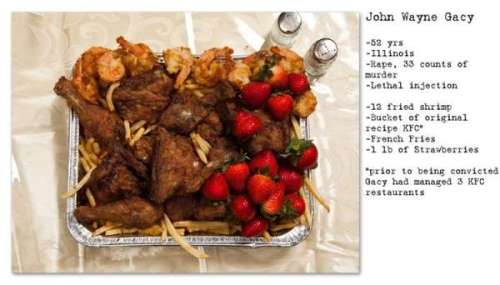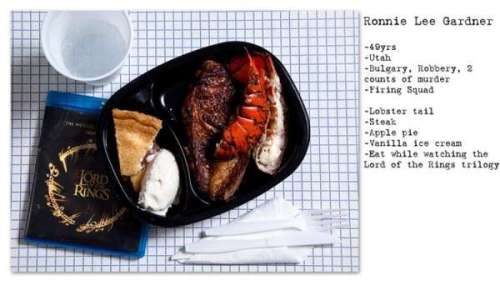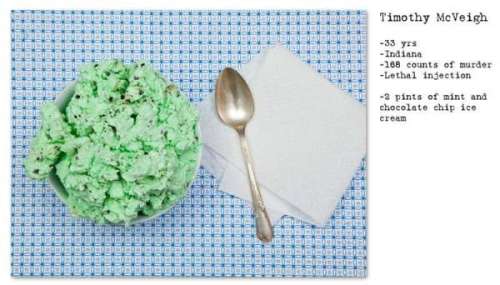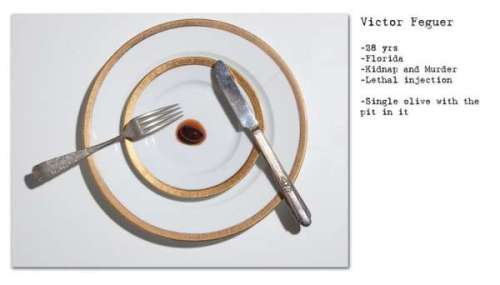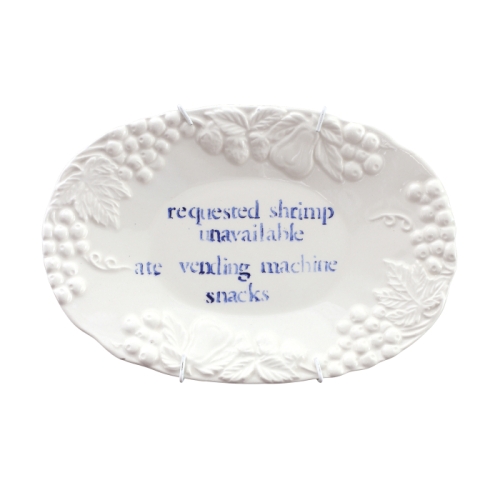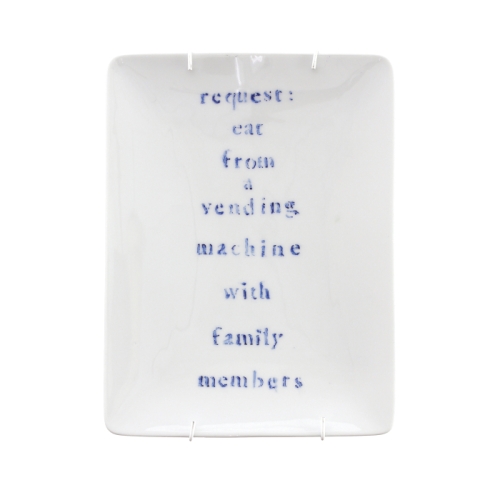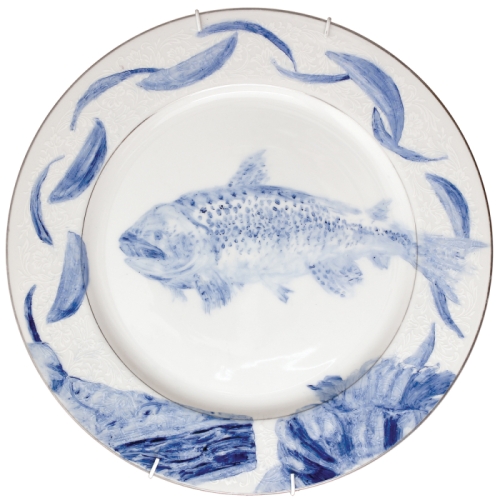It must be the bizarre combination of two essential factors in every life no matter who or where you are that has me and others intrigued about this subject. One happens to be an event that is commonly feared and mystified to extremes. The other is something that the majority of us look forward to – the juxtaposition of the two is already becoming crystal clear. People seem to be fixated with conveying the prison last meal and it probably has a lot to do with the myriad of contradictions engrossed in its ritual.
julia ziegler-haynes
Food is a fixture in our routine so it seems logical to ensure that it is enjoyed to the fullest with varieties of flavour and texture. Although, essentially food is simply a source of energy so we can continue living. To have a last meal just before you are put to death seems a bit pointless if you consider this angle. It has been reported that Barry Lee Fairchild, a convicted rapist and murderer believed “It’s just like putting gas in a car that don’t have no motor.” As pointless as it may sound there are books, articles and art projects all with the focus of this backwards regulation. Even the states of Arizona, California and (formerly) Texas have official websites publishing choices. To know what someone’s last dying wish is intrigues us, and it happens to fulfil this urge even more so when there is a common ground such as food.
Mat Collishaw
Historically, it was meant to act as a way to solidify forgiveness from the accused towards those who were systematically and physically involved in affirming the death sentence. By accepting the meal, prisoners are accepting their fate and making peace with the culpable parties. It was also thought the offering would deter the spirit from haunting those responsible and prevent its return as a malevolent spirit. In the past in parts of Europe, this would mean offenders physically sitting down with the hangman or headsman and sharing a drink or a meal! In Eighteenth century Bavaria you’d have a drink in your cell before the meal with your headsman. It was called St John’s Blessing in memory of St John the Baptist who forgave those who were about to behead him. Nowadays we seem to focus much more on the American last meal even though of course America is not the only place where the death penalty is still permitted. It does however stand as the only place where we are made aware in such detail of how it functions with regards to the meal.
celia a. shapiro
Food is social, cultural and can at times have political substance. There are those who decline a request of a special meal and there are those that speak volumes with what they desire. A person’s diet can have a lot of hidden clues as to who that individual is, the common phrase “you are what you eat” comes to mind. It isn’t a phrase born out of futility. You can find out a person’s: cultural and/or geographic location, social status, histories, economic status and some argue even an educational background can be deduced from a meal.
no seconds – henry Hargreaves
The name states a clear impossibility but there is something deeper. It also pays a sort of homage to Ricky Ray Rector who claimed he was saving his pecan pie for later. Prior to his execution date it was argued he should escape the penalty because his brain was impaired due to a failed suicide attempt. His pecan pie comment was seen as evidence his punishment was unjust by those in his defence.
There is Victor Feguer whose meal features above and who asked for a single olive with the pit in Iowa, 1963. It is questioned whether he actually ate it as some say the olive was found in his suit pocket after and others claim it was just the pit. Fegeur’s decision may have been based on the symbolism of rebirth as well as his apparent notion of peace. It is ironic as he was the last person to be executed in Iowa, so his death does mark a sort of rebirth with the abolition of an old system. Francois Mitterand (the 21st French President) who was not being executed but rather died of prostate cancer, had an extravagant last meal in 1996 consisting of oysters, foie gras, capon and roasted Ortolan. Ortolan is a small French songbird that was and is still illegal to kill/eat in France due to their endangered status. Apparently perceived as representing the soul of France, it is not only these factors that would have caused controversy. There is a connection this bird has to another bird of Mitterand’s meal -foie gras, in the specific and somewhat gruesome way in which it must be prepared. The bird is placed somewhere dark with an abundance of millet, the darkness causes a reaction in the ortolan where it constantly eats. It is then drowned in Armagnac, plucked, roasted and should be eaten whole. Adolf Eichmann, a senior Nazi official with major participation in the organisation of the Holocaust, who was executed in Israel, 1962, refused something to eat and instead asked for a bottle of dry, red, Israeli wine, apparently finishing half of it. Red wine is associated with blood and/or life, this symbolism exists outside the terms of Christianity. Therefore it feels like more than just coincidence that the only thing Eichmann consumed was red wine from an established nineteenth century Israeli winery.
Julie Green – the last supper
Starting in early 2000s, Green paints the meals in monochrome in support of the death penalty becoming abolished. Her objective is to paint 50 a year until the practice is ended. She paints past and modern executions. The physical form of the plates puts the numbers of lost life in perspective. The plates are a luxury the executed will never see, and while the condemned or their food choices may be presumed/considered to be unrefined, the style is a nod to the delicate method found in China. She has begun to visit exonerated inmates to find out what they had as their first meal on release and paints these in colour.

From food available in the cafeteria. Chose a turkey bologna sandwich with tomatoes and cheese, french fries, and an orange drink. Later, from a vending machine, got a Reese’s Cup, pretzels, and grape Sunkist drink.

Georgia, 2011. Refused to request a meal and asked to have the same meal as the other inmates – a cheeseburger, slaw, baked beans, potatoes and cookies.

Virginia, 2009. No final meal request because he remained hopeful to the end that he would not be executed.

Illinois, 1995. Filet mignon (medium well) with mushrooms, shellfish, baked potato, sour cream, brussels sprouts, salad with Italian dressing, corn on the cob, pistachio ice cream, cannoli.

Louisiana, 1999. Snickers candy bars, Baby Ruth candy bars, Hershey candy bars, chocolate ice cream, coconut pie, lemon pie, Cokes.

Indiana, 2007. Pizza and a birthday cake shared with 15 family and friends. A prison official said “He told us he never had a birthday cake so we ordered a birthday cake for him.”

Indiana, 2001. German ravioli and chicken dumplings prepared by his mother and prison dietary staff.

Ohio, 2010. A porterhouse steak, fried shrimp, barbecued chicken and ribs, a large salad, potato wedges, onion rings, sweet potato pie, chocolate ice cream and Hawaiian Punch to drink.

Alabama, 2011. In the final hours before the execution, refused to eat breakfast and wasn’t expected to eat dinner either, prison officials said. Did not request a special last meal, saying he was fasting today.

Texas, 2011. Two chicken-fried steaks, one pound of barbecued meat, a triple-patty bacon cheeseburger, a meat-lover’s pizza, three fajitas, an omelette, a bowl of okra, one pint of Blue Bell Ice Cream, some peanut-butter fudge with crushed peanuts and three root beers.
Lawrence Brewer (actual meal above), a white supremacist whose crime became international news at the time of his conviction, made international news once again in 2011 with his request and its repercussions. He ordered two chicken-fried steaks with gravy and sliced onions, a triple bacon cheeseburger, a cheese omelet with ground beef, tomatoes, onions, bell peppers and jalapeños, a bowl of fried okra with ketchup, a pound of barbecued meat with half a loaf of white bread, three fajitas, a meat pizza, a pint of Blue Bell vanilla Ice Cream, a slab of peanut butter fudge with crushed peanuts, three root beers. Even though some quantities were reduced due to policy it was still a hefty ask and once the feast arrived, Brewer refused to eat any of it. His bold statement resulted in such an opportunity being scrapped for future Texans. Since Brewer, death row prisoners are given the regular meal that the other inmates have, no frills, no fuss. In Brewer’s case, for me there is no question of his guilt in the atrocious crime he was accused of as he admitted he was there but denied direct involvement. If you decide to research the crime, it is clear that in the circumstances his presence would have been enough involvement to certify as guilty. What about those on death row who are accused of guilt but are actually innocent? Amnesty International and James Reynolds tackled this unfortunate reality with a series of last meals from inmates who had been killed for a crime they didn’t commit. By presenting the meals of those wrongfully killed in the same way in which it would have been served to them, we are forced to see their last moments. You look at the tray and imagine having to eat a meal knowing it will be your last even though it shouldn’t. Through the campaign, these innocent individuals and others like them are rightfully considered and reversed from condemned to helpless victims. At one point these men would have been painted as evil now instead it is those who agree with the death penalty that must re-assess their morals.
Go HERE if you are interested in knowing the faults in their cases.
Amnesty International x james reynolds
Life, death and food, are three elements of our being where whether we like it or not, are inescapable. It is maybe why there is a certain ease in the ability of them to be linked to one another. In major events, ceremonies or rituals of life and death, food is mostly always present. If not because of specific symbolic qualities particular foods have, food is simply a way of bringing people together, or it can help in occupying the mind and transporting the self elsewhere. However when it comes to the last meal, few of these optimistic ideals are applicable. In my research it seemed it is common for prisoners to fail at finishing a significant portion or to sometimes only be able to stomach liquids. Even food seems to lose its power when faced with certain death.
‘The underlying and compelling theme of the work is choice. What do people who may have lived for years in prison with virtually no choices at all do with this last one they’re offered?’ (The New York Times).

